Movie Review By: Mr. Roboto
Year: 1973
Directed by: Rainer Werner Fassbinder
Written by: Rainer Werner Fassbinder, Fritz Müller-Scherz, and Daniel F. Galouye (based on his novel “Simulacron-3″)
IMDB Reference
Degree of Cyberpunk Visuals: Low
Correlation to Cyberpunk Themes: High
Key Cast Members:
Fred Stiller: Klaus Löwitsch
Professor Henry Vollmer: Adrian Hoven
Günther Lause: Ivan Desny
Herbert Siskins: Karl Heinz Vosgerau
Eva Vollmer: Mascha Rabben
Gloria Fromm: Barbara Valentin
Franz Hahn: Wolfgang Schenck
Fritz Walfang: Günter Lamprecht
Rating: 9 out of 10
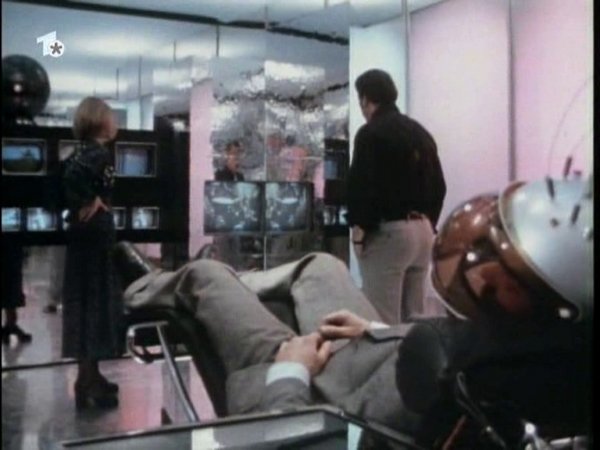
In Welt am Draht (World on a Wire), going into a simulation is referred to as “going downstairs” while coming out is “going upstairs.”
Overview: You think you might have seen every VR-based movie, or know what to expect after watching The Matrix or Lawnmower Man for the thousandth time. Then someone points you to some rare foreign TV miniseries, and suddenly… WHOA! The Matrix doesn’t seem so original anymore, at least in terms of concept.
Transmit ACK signal to “virtual reality 91″ for mentioning this one (just needed some time to research and download). World on a Wire is a two-part TV movie originally called Welt am Draht when it first premiered in West Germany. Since then, other VR movies short and long have come and gone. While still available via file-sharing and torrent, a recently restored version has been appearing at film festivals world wide and a Blu-Ray version is set to drop this month.
The Story: At The Institute for Kybernetik und Zukunftsforschung (Institute for Cybernetics and Future Sciences), or IKZ, Professor Henry Vollmer has created a simulated world containing some 8,000 “identity units”; Virtual humans not knowing that they are living in a simulation, except for the “contact unit” named Einstein who is needed to keep the simulation running. Vollmer tries to tell security chief Lause about a discovery regarding the simulation that he wants to keep secret “Because it would mean the end of this world.” Vollmer dies shortly after and Stiller takes over as the project’s technical director. At a party, Lause wants to tell Stiller what Vollmer had told him, but while Stiller is momentarily distracted Lause vanishes, and every one else suddenly has no memory of him, including Lause’s niece, Eva Vollmer. When one of the identity units tries to commit suicide it is deleted, prompting Stiller to “enter” the simulation to contact Einstein to find out why the unit tried to kill itself. When they meet again, Einstein is in Walfang’s body where he explains how he wants to be human… and how “reality” as Stiller knows it isn’t.
German Engineering. So the Simulacron computer system isn’t exactly 21st centruy, bleeding edge technology. This is a 1970’s era movie after all. So there’s no fancy gun-fu shootouts with CGI enhanced slow-motion effects, rotoscoped armor to guard against laser-edged Frisbees, or pixelated sex between Unix GUI daemons.
But Welt am Draht isn’t about fancy high tech special effects. It’s about one man’s reaction when he discovers the truth about reality… his reality, as he perceives it. We watch Stiller’s struggle to keep his sanity in a world that seems to be designed for the purpose of destroying him. A Kafkaesque nightmare encoded in silicon, and his attempt to escape it. And if he does escape, has he really escaped… or just entered a new level of the nightmare?
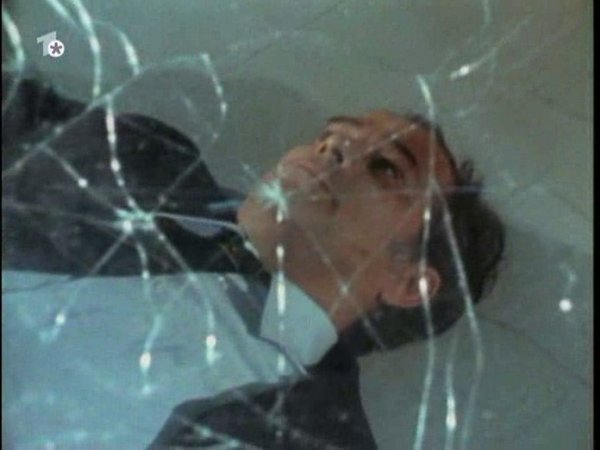
What we see now is like a dim image in a mirror. Then we shall see face to face.
Mirror’s edge. The main effect of the movie, especially in part one, is a shot of an image in a mirror or similar reflective surface. This gives an extra disorienting feeling as we ponder if reality really is reality, and how do they manage to get all those mirror-shots without the film crew appearing in the reflections. Low tech, highly effective.
But unless you can speak German well enough, you might miss some of the mirror-shots while trying to read the subtitles. That’s the only thing keeping this from being a perfect 10. Then again, subtitles probably would be better than dubbing that comes out as “all your wiener schnitzel are belong to us.”

Is it live? Or is it simulated?
Conclusion: From the country that gave the world cruise and ballistic missiles, Fahrvergnügen, and Kraftwerk, Germany shows that they can come up with some inventive… and scary… technology. Welt am Draht is one of those rare pre-cyberpunk cyberpunk movies that needs to be seen to be believed. Especially when more recent films have aped the idea of VR with high-end graphic trickery, this one is enough proof that high-end does not mean high-quality.
Movie Review By: Mr. Roboto
Year: 2011
Directed by: Andrew Bond & John Whoriskey
Written by: Ryan Dolton
Degree of Cyberpunk Visuals: High
Correlation to Cyberpunk Themes: Moderate
Key Cast Members:
James Donner: Mike Orie
Ora: Nadine Avola
Rating: 7 out of 10
Rust Valley - 35mm short. from RDolton on Vimeo.
Overview: Our forum member Burnt Lombard brought this net short to my attention earlier this week. Actually, I had a bookmark to it on Vimeo for a while, but that version is now password locked. More recently, I seen the trailer for it on Kovac’s screener of UCF: Abstract Messiah. Now that I’ve invested the 17.5 minutes to watch, I got to give Lombard his creds for getting me to watch. Imagine, if you will, a little of what a live-action System Shock movie could be like…
The Story: ASEMS pilot James Donner has spent the past 1000+ days (3 years) in space and is now on his way home for some hard-earned R-and-R. Then he gets a call from some corporate dick:
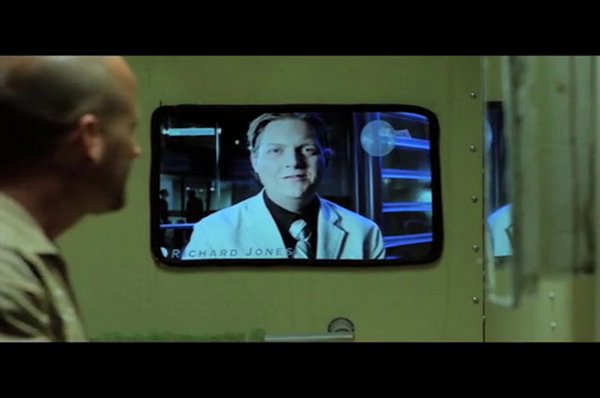
“We’ve been out of contact with the Valley Isis colony for eight months now. We just received a distress signal and…”
So much for vay-kay. Against his better judgement, Donner boards the colony when he hears a female survivor, Ora, over his radio.

I’d rescue that for a dollar!
When Donner finds Ora, that when he has to make a choice…
But, is it cyberpunk? Rust Valley has been tagged as cyberpunk on Vimeo, and it does make its case well. We have the ASEMS corp, though the full extent of their power and influence wasn’t revealed. There’s a bit of man-machine fusion (won’t say where due to spoiler possibility). But it’s the visuals that makes the short cyberpunk. Let’s just say that there’s a reason why it’s called RUST Valley.
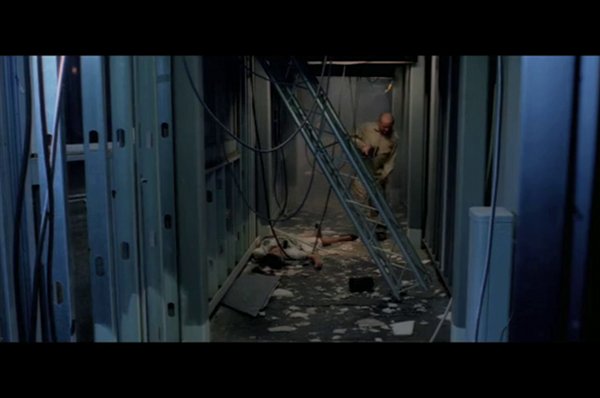
The audience is now deaf. Being an amateur production, and shot on 35mm film, some technical glitches are expected. But when you have to turn up the volume to hear the monitor voices, you might want to consider amplifying the microphones for the monitor actors.
UPDATE: Burnt Lombard has uploaded the official video on Vimeo, with improved audio. It’s a bit different in other ways as well, but with the improved audio I’ve decided to upgrade its rating to 7.
Conclusion: While not the most polished production, this short still manages to make for good cyberpunk viewing. And for a bonus, there’s an alternate ending that was supposed to be the original ending. This could make for a good feature… just pray that it doesn’t become the next Snakes On A Plane.
Movie Review By: Mr. Roboto
Year: 2009
Directed by: Aleksa Gajic, Nebojsa Andric, Stevan Djordjevic
Written by: Aleksa Gajic
IMDB Reference
Degree of Cyberpunk Visuals: High
Correlation to Cyberpunk Themes: High
Key Cast Members:
Edit (voice): Sanda Knezevic
Bojan (voice): Nikola Djuricko
Broni (voice): Marija Karan
Profesor Dorijevic (voice): Vlasta Velisavljevic
Edi (voice): Nebojsa Glogovac
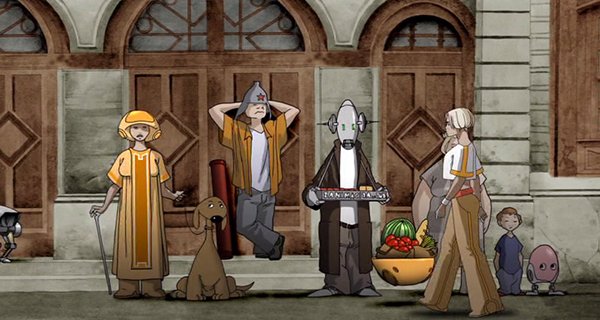
Overview: Not often that a good cyberpunk movie comes down the wires. Lately, the better ones have been coming out of Japan’s anime studios. Technotise could be the latest-and-greatest to come from the land of the rising sun… only it came from Serbia, not Japan, although the anime influence can be seen. While not enough to make those famed anime studios nervous… yet… it already has a live-action remake under development.
A sequel based on the comic (readable here, if you understand Serbian), Technotise looks into a bit of the the life of a college girl as she faces a struggle in Belgrade 2074 that could kill her.
The Story: Edit Stefanović is a psychology major in a Belgrade college. Like most students, Edit has had her successes and failures but mostly failures. Now her professor has given her an ultimatum:

“Pass or GTFO.”
After burying her robotic pet, and a fight with her mother, Edit decides to get a memory chip implant to help her pass the exam. She is also an intern at TDR, a research company that’s been working on a formula that connects all the energies in the world, aka “A direct line to God.” This “formula” can be used to predict the future, but any computer that calculates it becomes sentient before it shuts down. Abel Mustafov discovered the formula before becoming autistic, and when Edit sees a “graph” of the formula, her chip becomes alive and starts wiring itself into her body, making her act weird (like eating large amounts of iron). Now TDR wants Edit and the chip for their future-telling computers, while Edit wants what the chip did to her undone.

Algorithm Absurd. This phrase is used a couple of times to describe what happens to the computers that calculates the formula. Algorithm - like a computer program; A series of finite steps to generate an output from input. Absurd, the ludicrous, insane, irrational. The phrase is simply another way of saying: “That does not compute.” Apparently the computers see the formula like a digital existential crisis, one that says machines are not alive. But Edit’s chip doesn’t suffer the same fate, probably because of their connection to each other, or maybe because of Edit’s study of psychology she was able to “understand” the graph in a way that computers couldn’t so she acted as a “buffer” and the chip was able to process her output.
The next GITS? Like GITS, Technotise uses a variety of animation styles to produce some high quality movie fare. 2D, 3D, vector, and realistic static drawings come together for some of the best eye-candy. But without a good storyline, all you can get from eye-candy is diabetes. Fortunately, Technotise has the storyline to back up the visuals. About the only problem is the language is entirely Serbian with English subtitles so you might miss out on some of the vids.
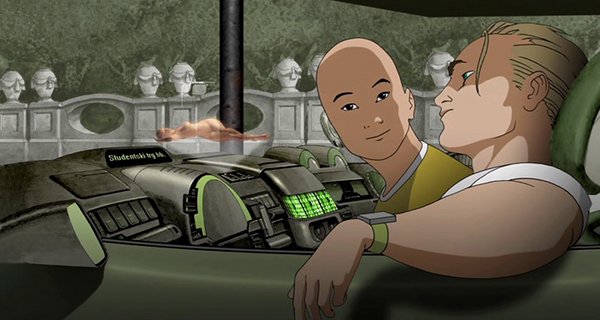
“I have nothing against plastic but sometimes you have to make out with some real meat.”
Conclusion: With the themes of the search for “God” via science and our continued interconnection of human and machine, we have some excellent cyberpunk fare to even anime fans happy for the next decade or so. This is one animated movie that can go byte-by-byte with GITS. Just get the DVD and see what I mean…
Movie Review By: Mr. Roboto
Year: 2010
Directed by: Joseph Kosinski
Written by: Edward Kitsis and Adam Horowitz (story & screenplay), & Brian Klugman and Lee Sternthal (story)
IMDB Reference
Degree of Cyberpunk Visuals: High
Correlation to Cyberpunk Themes: High
Key Cast Members:
Kevin Flynn / Clu: Jeff Bridges
Sam Flynn: Garrett Hedlund
Quorra: Olivia Wilde
Alan Bradley / Tron: Bruce Boxleitner
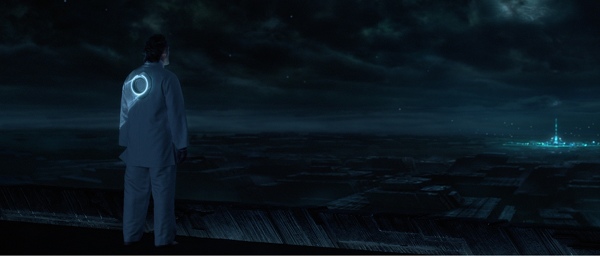
“The Grid. A digital frontier. I tried to picture clusters of information as they traveled through the computer. Ships, motorcycles. With the circuits like freeways. I kept dreaming of a world I thought I’d never see. And then, one day… i got in.” - Opening lines spoken by Kevin Flynn (Bridges)
Overview: Thirty years is a lllllllllloooooooooonnnnnnnnnnggggg time to wait between movies in a franchise; Lots of changes happen in such a time period, especially in technology. After a concept “trailer” for Legacy was leaked to the nets after appearing at ComiCon 08, Disney gave the sequel the green light. Was it worth the effort?
Visually, Legacy makes the original look obsolete thanks to the past thirty-year advancement in computer and cinema technology. The storyline probably could be better, though the concept of one’s vision of Utopia being usurped in the name of godlike power still makes for some good cyberpunk fare in a virtual world.
The Story: Since taking over Encom in 1982, Kevin Flynn (Bridges) had been dividing his time working on “The Grid,” running Encom, and raising his son, Sam. Then he disappeared, leaving Encom in chaos and Sam without a father. Alan Bradley (Boxleitner) receives a page from Flynn’s Arcade which had been shut down twenty years ago. Sam goes to the arcade and discovers a secret lab in the basement, complete with the digitizing laser that sent Flynn into the Grid. Sam activates the laser and is uploaded into the Grid himself. After being made to play games, he finds his father, who explains why he was stuck in The Grid… and the tragedy caused by Clu.
Eye and Ear Candy. As mentioned before, the advances in computers and movie making has given Legacy a vastly superior visual look. Gone are the clunky looking gray “armor” suits with post-production rotoscope effects in favor of skintight leather/latex jumpsuits with embedded lights. The Frisbee “identity disks” are now chakram-style rings. Light cycles, recognizers, … everything now has a sleeker, updated look. They look more like real models relying less on computer generation… but then again… can you tell the difference?
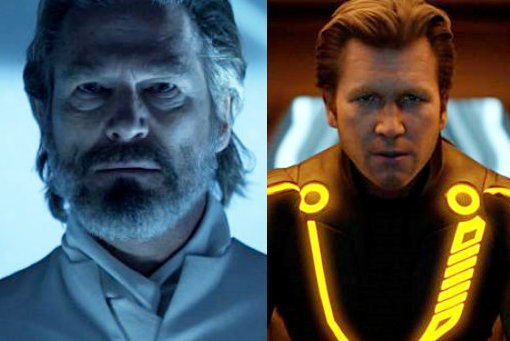
Even Jeff Bridges gets a CGI “facelift.”
Also, the movies was shot entirely in 3D as opposed to being shot in 2D and converted post-production.
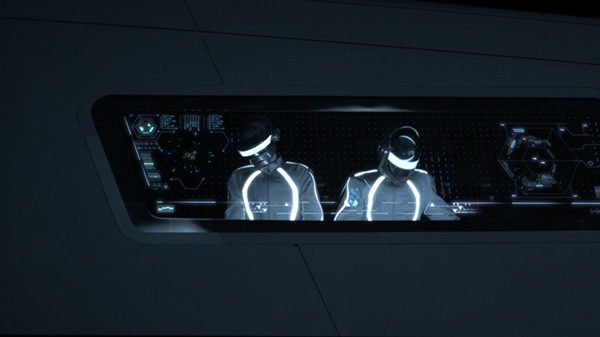
At the End of Line club, you’ll get some brief glimpses of Daft Punk rocking the data block. You can hear their music throughout the movie… that’s assuming your ears haven’t been blown out by the extra-loud crashes and explosions.
Conclusion: Comparing Legacy to the original would be like comparing a modern, quad-core multi-gigabyte machine with a terabyte hard drive and NVIDIA graphics (no offense to ATI fans) to the original IBM PC model 5150. Comparing it to the more recent cyberpunk fare, Legacy is certainly better than what has been coming down the wires lately. Any cyberpunk fan should see it if just for the eye candy, maybe for the story too. Tron fans will definitely want to see Legacy.
Do us a favor Disney: If you’re going to do a Tron 3.0, don’t wait another thirty years. Some of us may not be around to see it.
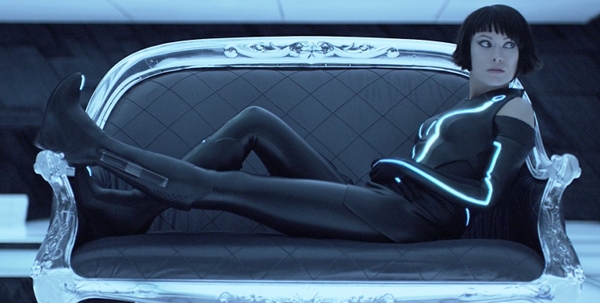
Movie Review By: Mr. Roboto
Year: 2010
Directed by: Richard Clabaugh
Written by: Fran Clabaugh and Richard Clabaugh
IMDB Reference
Degree of Cyberpunk Visuals: Moderate
Correlation to Cyberpunk Themes: High
Key Cast Members:
R. J. ‘Gunner’ Reynolds: Adrian Paul
Barbara Hawkins: Megan Blake
Jarett Hewes: Luke Eberl
G-Man: Danny Trejo
Rating: 7 out of 10
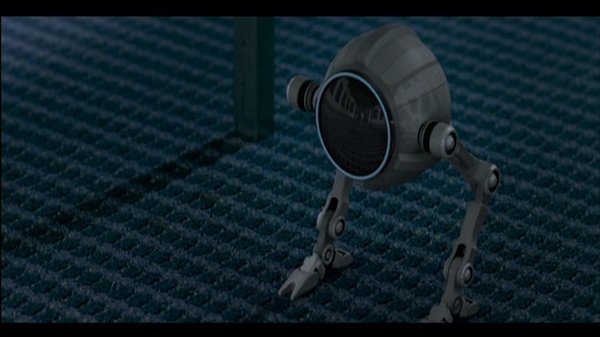
“I see what you did there…”
Overview: With the upcoming anniversary of 9/11, one has to wonder how far our security-surveillance panopticon prison planet has come. Britons have seen a rise in the Orwellian nightmare, while Americans have had something of a reprieve from the “Patriot” Act, although other forces may be taking over that role. Eyeborgs breeds 1984 with The Matrix to create a new form of high-tech overlord scenario.
I probably would have missed this one if it wasn’t for my DVD club. While the “borgs” of Eyeborgs caught my initial attention, the description of the story is what sold me on it. After watching it, I was glad I had a chance to see it, even if it was direct-to-video. While not up to Terminator or Robocop standards, this is one of the better movies to come down the wires in some time.
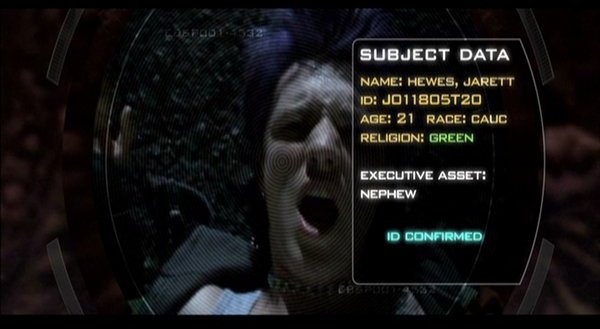
That’s no punk, that’s President Hewes’s nephew.
The Story: The on-going threat of terrorism has led to the adoption of the “Freedom of Observation” act. This gives the Department of Homeland Security new weapons in their surveillance of US citizens. Among them are the “Eyeborgs,” cameras with robotic legs that allow them to move around. Coordinating them, and the millions of already existing stationary cameras, is the Optical Defense Intelligent Network… “O.D.I.N.” for short.
DHS agent R.J. “Gunner” Reynolds (Paul) is observing a gun sale to a possible terrorist whose targeting President Hewes. The person gets away, but is later caught when eyeborgs see his bike at a punk show where the President’s nephew, Jarett, is playing with his band. The person is captured for targeting Jarett and interrogated at a DHS office. Leaving the man alone for a few minutes, he manages to escape when the eyeborgs in the room attack him. He dies later when the eyeborgs force him over a railing and causing him to fall six stories to his death. It was determined via surveillance cameras that Reynolds left the door unlocked allowing the man to escape, but Reynolds did lock the door. He begins questioning the integrity of O.D.I.N. as other people involved with the investigation die in mysterious ways while the eyeborgs give a very different version of the truth.

“See with your own eyes… not theirs.”
O Say Can You See? Just when you the plot is pretty much cut-and-dried, the big twist comes when Reynolds tries to get Jarett from the Presidential Debate. That’s when Reynolds, and the viewers, figure out what the truth is. O.D.I.N. has been manipulating reality, or whoever is manipulating O.D.I.N. to manipulate reality, for their own end.

“Everybody knows that videos can be faked. Regardless of the motives of the people, they’re designed to confuse you, so you must ask yourself, each and every citizen of this country, ask yourself one question and one question only - Who do you believe? A government that is sworn to protect you, or a ratings-hungry media beholden to no one?”
For the most part the movies works well, but you might see a problem with some of the eyeborgs late in the movie. The colors reflecting from the machines feel “off,” and some of the eyeborgs appear to be two-dimensional sprites instead of 3D during the rescue scene. Probably a result of being rushed to video.
Conclusion: Given the current state of terrorism-generated paranoia, Eyeborgs seems like just the ticket to stoke those tin-foil hat fires. While it may have avoided theatrical release (and competition from Iron Man 2), it shouldn’t be left out of your home video collection, especially with recent disappointments from Hollywood.
Movie Review By: Mr. Roboto
Year: 1998
Directed by: Mick Garris
Written by: Preston Sturges, Jr. and Mick Garris (teleplay), Peter James (based on his novel “Host”)
IMDB Reference
Degree of Cyberpunk Visuals: Moderate
Correlation to Cyberpunk Themes: Moderate
Key Cast Members:
Dr. Joe Messenger: Peter Gallagher
Karen Messenger: Mimi Rogers
Juliet Spring: Bridgette Wilson
Albert: Tom Nibley
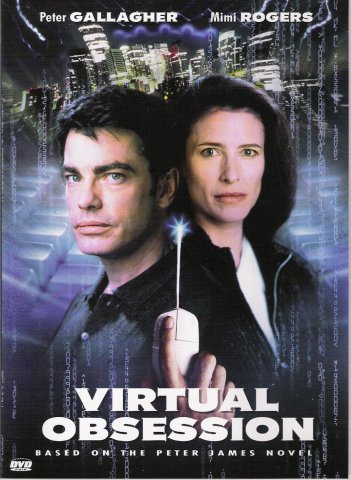
Overview: Originally, it was a made-for-TV movie that aired on ABC (who said “It makes Fatal Attraction seem like a walk in the park.”), now it makes its rounds on cable under the name Host.
I came across this little ditty a few weeks ago at a local flea market. By the way the cover looked, and the story description on the back of the case, I had the impression that this was a cyberpunk movie. After doing some research and discovering it was made by Hallmark Entertainment, VO suddenly went from possible cyberpunk movie to “chick-flick” … not what I was looking for. Still, the plot description kept nagging me to watch it. So I did…
It’s definitely a direct-to-TV-quality melodrama, but there are some undertones of cyberpunk, especially with technology redefining humanity.
Synopsis: Dr. Joe Messenger has created the ultimate super-computer to run Salt Lake City’s power grid, but “Albert” (as in “Einstein,” who appears as a holograph at times) has a greater purpose: Cameras, microphones, and other sensory-input devices from around the city… and the world… feed Albert data constantly, helping it learn about humanity. Joe is looking to create the first post-biological consciousness.
Joe hires Juliet Spring to assist him, but her life is threatened by an inoperable aneurysm. She is desperate to use Albert for a project of her own: Juliet wants to upload a human brain (hers specifically) to achieve immortality, or at least until they discover a way to operate on it while she is in cryogenic sleep. Juliet begins an affair with Joe, putting a strain on his marriage, and slowly becomes obsessed with him. Just before she dies, she uploads herself to Albert and her body is frozen. While in deep-freeze, people start making demands for her body and eventually it is destroyed (the sad finale is when Karen discovers Juliet’s head in the basement freezer and, after confronting Joe, tosses it into the street where it shatters into chunky pieces). Juliet begins using Albert’s connections to take revenge, and demands that Joe joins her in her “Eden,” going so far as threatening his family.
Fatal Attraction, fer sure! The only thing missing is the obligatory “I’m not gonna be ignored, Dan!” line. From the first time we see her during the interview at the Artificial Intelligence Center, we can tell Juliet is targeting Dr. Messenger for something. Even after her death and destruction, she is still desperate to have Joe with her.
If it wasn’t for the Lawnmower Man-like idea of uploading a consciousness into cyberspace, this would just be another psychotart-gets-wet-panties-for-cuckold film.
Now for the good parts! Fortunately, the more memorable scenes and lines in the movie deal more with the impact of technology on the meaning of humanity than on one girl’s obsession for a married man:

“We’re trying to create a new consciousness… We’re trying to crate a mind. Something aware of itself… A being that can think and choose for itself, on its own terms.”
“We’re not living in a science fiction movie, Carl. Post-biological man is to be pure intelligence. There wouldn’t be any selfish interest….” To test Juliet’s theory, they try to upload a rat’s brain into Albert. They succeed, though the rat dies with a high-pitched shriek:

“Here’s my hypothesis. The rat brain is downloaded and at time point zero, it becomes conscious. It responds to its newborn consciousness with that sound. And somewhere between zero and 21-point-734 seconds it senses competition with the living rat, the organic rat, and kills it.”
“What if silicon consciousness is unbearable to creatures that were once alive, once organic? What if stripping the consciousness from the body is agony?” After uploading herself to Albert and “seeing” her meat body be destroyed, Juliet undergoes some major personality changes, becoming almost god-like (or goddess-like):
“Maybe you can’t separate the body from the mind. Maybe there’s something that binds us to the flesh. Loose the body and you loose the humanity. Destroy the container and you destroy the soul.”
“Imagine what an active intelligence with spontaneous access to all of mankind’s recorded knowledge is capable of.” 
What do you call a computerized brain that turns a city’s light grid into a message board? Insane in the mainframe.
Conclusion: While not the most “hard core” in terms of cyberpunk themes and visuals, there is enough cyber-transhuman philosophizing to make this made-for-TV chick-flick interesting for guys to check out… IF you have stomach for such fare.

Movie Review By: Mr. Roboto
Year: 2005
Directed by: Rob Cohen
Written by: W.D. Richter
IMDB Reference
Degree of Cyberpunk Visuals: Very Low
Correlation to Cyberpunk Themes: Low
Key Cast Members:
Lt. Ben Gannon: Josh Lucas
Lt. Kara Wade: Jessica Biel
Lt. Henry Purcell: Jamie Foxx
Capt. George Cummings: Sam Shepard
Dr. Keith Orbit: Richard Roxburgh
EDI (voice): Wentworth Miller
Overview: We, who do reviews for Cyberpunk Review, sometimes feel the need to review such crappy media not only to let you know what is/is not cyberpunk, but what stuff is truly deserving of the label “crap.” Stealth is such a movie, as it attempts to be Top Gun, Firefox, and The Terminator in one overstuffed turkey. Jamie Foxx was better off behind a piano as music legend Ray Charles than he was in the cockpit of this doomed flight.
So why bother doing a review of it anyway? If you’ve seen the plot synopsis of Stealth as I have, you might have been tempted to call this cyberpunk, too:
The Story: The near future US military is engaged in a war against terrorism (still?), and they’re investigating any and all technologies to help strike the enemies heavily, quickly, and quietly. The result: The F/A-37 Talon, a multi-purpose aircraft that can out-shoot and out-fly any aircraft. Three pilots are selected out of four hundred applicants as they achieve perfect scores during a field test and are assigned to the aircraft carrier USS Abraham Lincoln. There, the trio learn they will be joined by a fourth, an unmanned combat air vehicle (UCAV) known as the Extreme Deep Infiltrator, EDI or “Eddie” as everyone calls it.
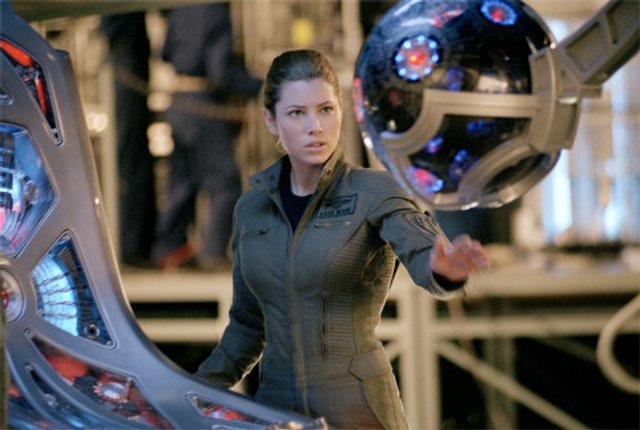
EDI is not just a UCAV; The “pilot” of EDI is a quantum computer with a highly advanced AI on a neuronal network. This gives EDI the ability to learn quickly, as the rest of the Talon squadron are initially instructed to teach what they know to it. It’s EDI’s appearance that triggers a debate about the use of robots in wars: How humans can appreciate the perils and ugliness of war, while machines can exceed human performance without being subject to the emotional baggage.
Negative impact of technology? Check. This ethical debate makes the first half of the movie a bit more interesting as we watch the EDI and Talons take on their first mission: The heads of three terrorist cells are meeting in Rangoon, and the squadron must take them out.
EDI gathers intelligence about the terrorists from satellites and even retinal scans (Ubiquitous access to information. OK.), and comes up with a way to take them out without innocent casualties. EDI is ordered to make the kill, but Gannon belays that order and makes the shot himself. While the squadron returns to the Abraham Lincoln, EDI is struck by lightning and starts to take on some human characteristics: EDI starts learning at an exponential rate, develops ethics and an ego, and even downloads all the music files from the Internet. Man-Machine fusion? Sounds like it.
Second mission: Terrorists have acquired nuclear warheads. The squadron must take them out, but the mission is aborted when it is discover the warheads cannot be destroyed without fallout causing civilian casualties. EDI attacks anyway, citing Gannon’s disobedience in the previous mission. The squadron is now ordered to escort EDI back to the Abraham Lincoln, take control of it, or shoot it out of the sky.
From there, Stealth degenerates into another cookie-cutter action movie that crashes and burns, like Purcell does when he tries to chase EDI. The debris damages Wade’s jet and forces her to return to the carrier, only to eject over North Korea, and leaves Gannon to hunt down EDI.
Nothing more to see. Well, maybe a little bit… If you’re looking for a focus on the underground, you’ll find nothing. Then again, you really can’t focus on the underground when doing Mach 5 above the Earth.
On the other hand, there is some evidence of someone trying to control society, at least the Navy anyway. Throughout the movie the carrier’s captain is seen talking on the phone to a Congressman who seems to have a vested interest in the EDI program. Also, after Gannon crash-lands in Alaska, some black-ops types try to kill him, but escapes with the help of EDI’s creator, Keith Orbit.
This is the problem in trying to call Stealth cyberpunk: The themes are there, just not enough to call it cyberpunk. And not enough to even call this dodo a “good movie.” Leave this bird on the runway, or stay within reach of the ejector button if you insist on watching.

Attention, passengers. Due to terminal crappines, this flight has been canceled PERMANENTLY! Thank you for flying Cyberpunk Review Airlines.
Don’t worry, folks. Last weekend, I came across a DVD that sounded like it was very much cyberpunk, and I have a couple of others to watch and review, with some other titles from the forums to check, so we’ll have some real cyberpunk movies for you to enjoy.
Movie Review By: SFAM
Year: 1989
Directed by: Masato Harada, Adam Smithee
Written by: Jim Bannon, Masato Harada, Adam Smithee
IMDB Reference
Degree of Cyberpunk Visuals: Medium
Correlation to Cyberpunk Themes: Low
Key Cast Members:
Brooklyn: Masahiro Takashima
Texas Air Ranger Sgt. Nim: Brenda Bakke
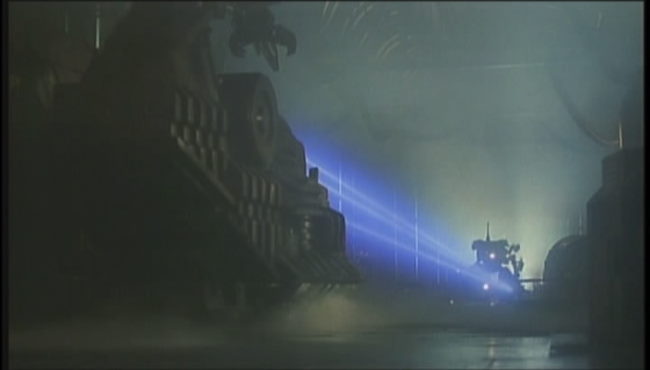
Overview: Gunhed is a Japanese live-action Mecha-Transformers movie done up in low-budget, gritty cyberpunk style. Unfortunately, it gives us a set of almost irreconcilable issues. On the one hand, the low-budget robots are pretty cool, as are a number of other low-budget FX. Yet, these are packaged in a barrage of incoherent plot points and truly strange sound decisions (the Japanese actors speak Japanese while the American actors speak English). When you see “Adam Smithee” in the director’s spot, you know something has gone wrong – in this case, the answer is clearly the editing. Gunhed may qualify for the worst editing of all time.
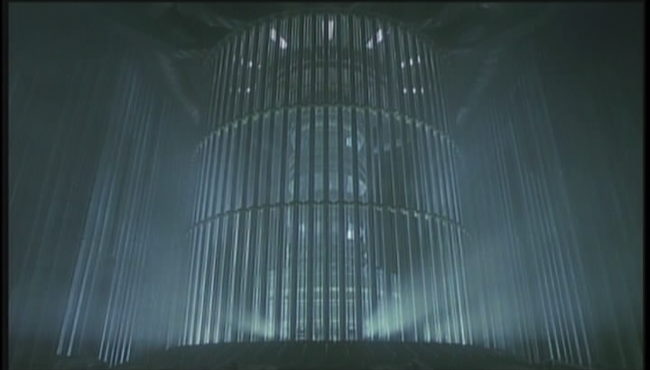
The Story: A Robot War ensued an a small robot production island in the Pacific in the year 2025, where sentient supercomputer, Kyron 5, has decided that Mankind was irrelevant. A mecha battalion of Gunhed warriors – huge transformer style tanks – were dispatched to eliminate Kryon 5. They didn’t succeed, but Kyron 5 was essentially marginalized, so no more force was sent. Now, 13 years later, due to a depletion of world resources, the key component that creates supercomputers, Texmexium (I shit you not – this is the name!), is in short supply, as are spare microchips. A group of scavengers have decided to enter the “forbidden zone” and go to the Island in the hopes of collecting Gunhed chips, which are now worth more than gold.
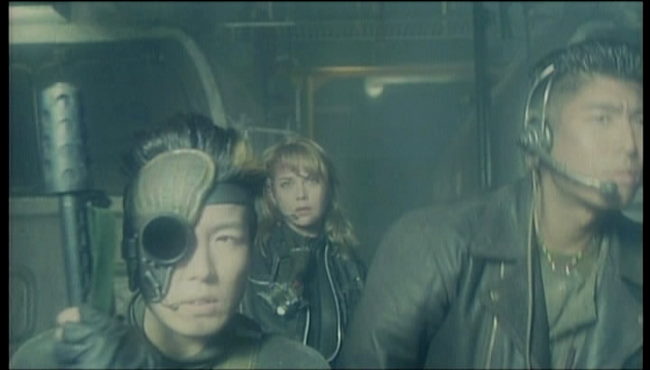
When the get to the Island, they quickly learn that Kyron 5’s protections are degraded but still seem in place. At first Kyron 5 doesn’t recognize their presence (you’d think it would notice a plane landing, but I guess not – nor do we find out why they didn’t just bomb the Island from the air back in 2025). But quickly it’s defenses, headed up by a fly-eyed looking “bio-droid” come to challenge the scavengers. Along the way, the find the remnants of a Texas Air Ranger helicopter, which still has a passenger, Sergeant Nim (Brenda Bakke). As things progress, most of the scavengers die in gruesome ways, until only Sergeant Nim and a mechanic named Brooklyn (Masahiro Takashima) survive – but due to the Island’s defenses, they are stuck there unless they can destroy Kyron 5. Also, they have stolen the Kryon 5’s supply of Texmexium (perhaps this is constructed from stale tacos), and now the Biodroid wants them back.
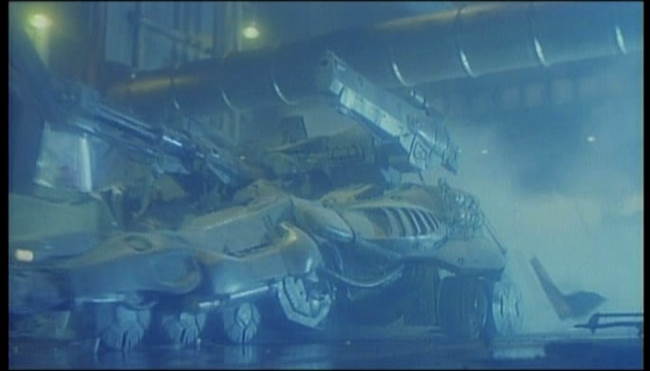
But that’s not all! Apparently some kids live on this Island (where they came from, we have NO idea), and they’ve decided to help Brooklyn and Sergeant destroy Kyron 5. But wait – there’s more! It turns out that one of the Gunhead tanks from 2025 appears salvageable, so Brooklyn attempts to revive Gunhed while Sergeant Nim goes off to do something unspecified (but at least it looks important). An incoherent sequence of actions ensues, whereby Brooklyn tries to bring the Gunhed to destroy Kyron 5. As he gets close, their biggest challenge awaits – Kyron 5 has resurrected a Gunhed of his own!
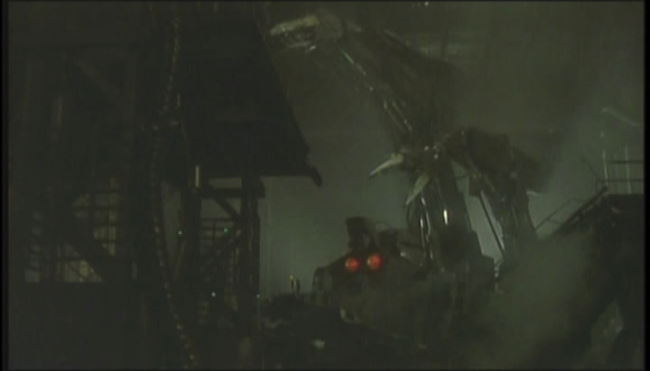
The Editing: Gunhed could have potentially been a decent, low budget movie, but the editing kills it. Continually, we see random actors popping out in places that don’t make sense, and whole streams sequences are rendered incoherent based on completely haphazard editing choices. I’m going out on a limb and guessing that at some point, the script was relatively simple and straightforward, but due to the editing, Gunhed was transformed into an absolute mess. But perhaps this is just the English version - does anyone know if the Japanese version is different?
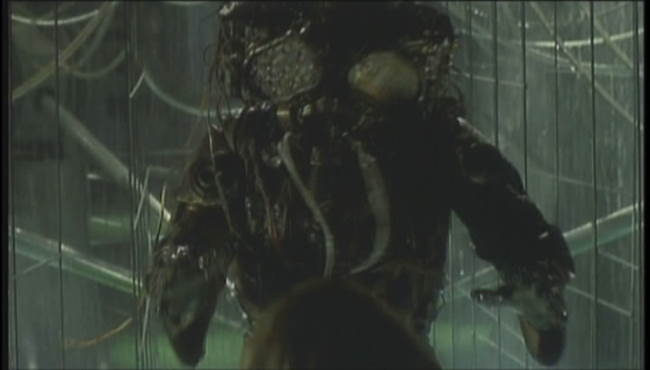
The FX: Yes, the effects are all low-budget, and yes, it appears as if the entire movie takes place in a small factory, where the same locations are used over and over again only with different camera angles, and no, the tanks really don’t have any flexible movement. Still, even with the problems and all Gunhed has some enjoyable shots. The biodroid is pretty low quality, but the factory looked realistic enough, and every now and then, you get some cool, low budget effects. The Mecha-transformer fight is especially fun. .
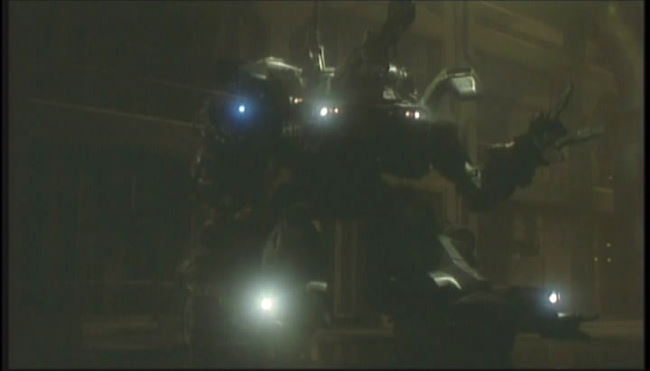
The Bottom Line: The fact that the actors speak different languages but apparently understand each other perfectly really describes the state of Gunhed – it’s interesting but never seems to hang together well. Most egregious is the Biodroid, which has swallowed one of the scavengers whole, and now has to deal with someone inside itself stopping it from killing the rest of the people (the hows and whys of this are never explained). The appearance of the kids pretty much destroy all possibility of a believable story. On the other hand, we get Brenda Bakke doing her best sultry Lauren Bacall impression, which works somewhat well. Unfortunately, her partner, Masahiro Takashima isn’t up to taking a leading role. Watch this for the Mecha fight if you like, but the movie as a whole just doesn’t work.
~See movies similar to this one~
Movie Review By: SFAM
Year: 2002
Directed by: Terry Cunningham
Written by: Flavia Carrozzi, Terry Cunningham & Steve Latshaw
IMDB Reference
Degree of Cyberpunk Visuals: Low
Correlation to Cyberpunk Themes: Medium
Key Cast Members:
Nick ‘Jester’ Chase: Nick Cornish
Neville: Adrian Paul
Skylar: Bai Ling
Tess Woodward: Vanessa Marcil
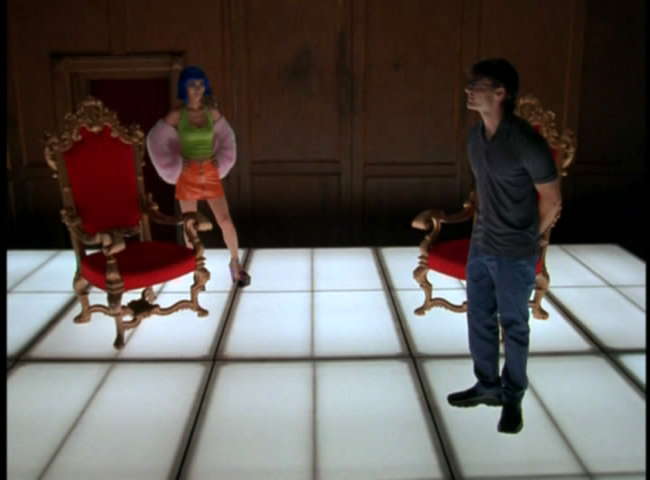
Overview: Overview: Codehunter (a.k.a. Storm Watch) is a fun, but absurd low budget AI and VR flick. This is not a movie who’s technical plot holds together, but it does work as a bubble-gum current-setting hacker-cyberpunk romp. Code Hunter is another War Games-Hacker-Colossus, the Forbin Project rip-off, but in a simplistic and enjoyable way. I’m a sucker for movies with either Bai Ling and Adrian Paul in it. Along with those two, the supporting cast which includes Babylon Five’s Jerry Doyle, Vanessa Marcil and Nora Dunn is pretty fun too.
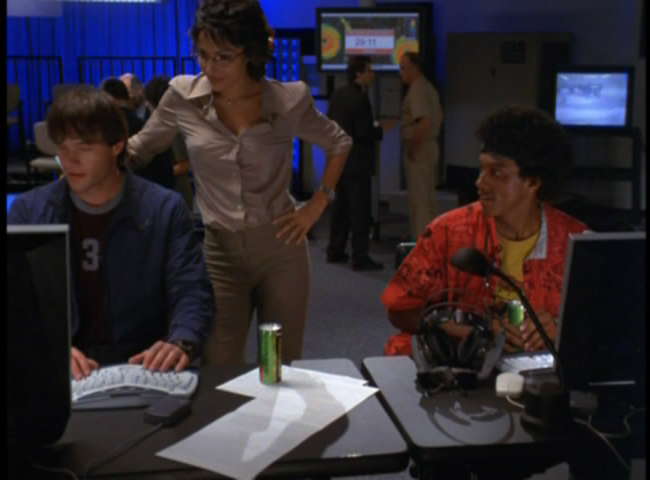
The Story: Nick “Jester” Chase (played by Nick Cornish) is a reformed hacker who likes to hang out in a VR first person shooter game called Shock. Simultaneously, a small computer firm is attempting to sell the US Navy on a new satellite system called “Thunderhead,” which is designed to control the weather. Nick is contacted in the game by Skylar (Bai Ling), a computer genius extraordinaire, to steal a file from an unknown computer system. After refusing, Skylar blackmails Nick by modifying his record to make him a wanted fugitive. Skylar agrees to steal the file, but then hides it and tries to go to the news station to seek protection. He enlists the aid of up and coming reporter, Tess Woodward (Vanessa Marcil), who agrees to help him.
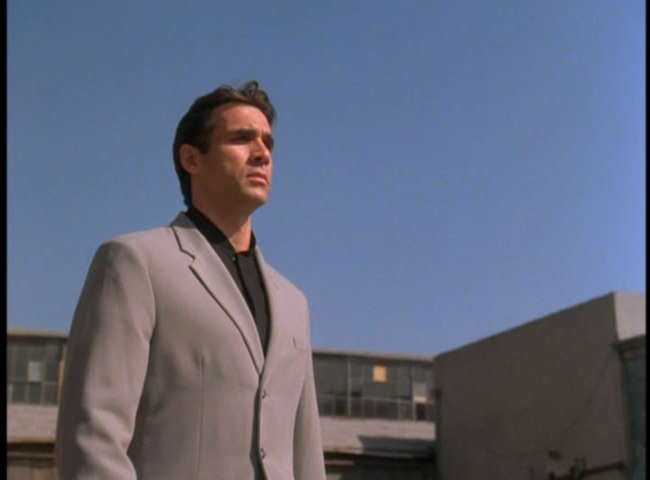
Unfortunately, Thunderhead appears to be out of control, and has created two massive hurricanes on each side of the US that will devastate the both coasts, causing potentially millions of deaths and billions in damages. The government tracks down Nick and bring him in for questioning. As the plot unfolds, it appears that a strange connection between the VR game “Shock” and Thunderhead emerges. Unless they can unravel it, the consequences will be catastrophic.

The Bottom Line: Although the cast is fun, and the pacing is good, the actual plot points and coherency are well past the point of believability. They are too numerous to count, but suffice to say the good guys had a number of obvious solutions that could have stopped the catastrophe. To add insult to injury, the movie overstretches its AI angle – had it stopped earlier, it would have worked within the narrative, but instead, they go for the sappy “teach me all of humanity” angle. Again, the movie is fun to watch, but lacks any real intelligence.
~See movies similar to this one~
Movie Review By: SFAM
Year: 2004
Directed by: Alex Proyas
Written by: Jeff Vintar & Akiva Goldsman, based on book by Isaac Asimov
IMDB Reference
Degree of Cyberpunk Visuals: High
Correlation to Cyberpunk Themes: High
Key Cast Members:
Sonny: Alan Tudyk
Del Spooner: Will Smith
Susan Calvin: Bridget Moynahan
Dr. Alfred Lanning: James Cromwell
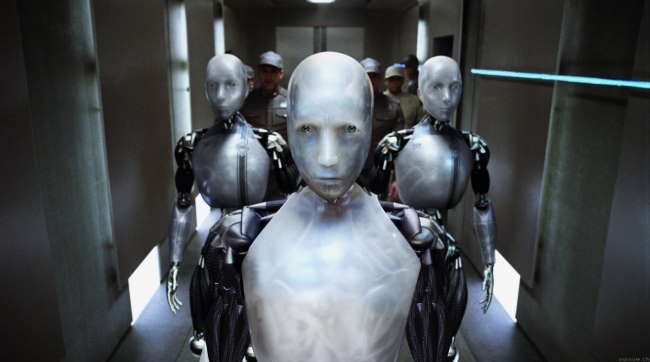
The Three Laws of Robotics
1. A robot may not injure a human being, or, through inaction, allow a human being to come to harm.
2. A robot must obey orders given it by human beings, except where such orders would conflict with the First Law.
3. A robot must protect its own existence as long as such protection does not conflict with the First or Second Law.
Overview: Superficially based on Asimov’s great collection of short stories - “I, Robot” – this movie of the same name usually sacrifices intelligent Sci-Fi for overblown summer blockbuster clichés. While Asimov fans will recognize the names of Dr. Alfred Lanning, Dr. Susan Calvin and Lawrence Robertson, they won’t recognize the characters that Proyas gives us. In yet another, “The evil robots are coming to control us” movie. I, Robot delivers eye-popping, often well over-the-top FX from beginning to end. Right at the beginning, I, Robot relays to us that they’ve set the bar low by spending the first five minutes delivering Converse Shoe and Fed-ex Delivery commercials. Still, I, Robot captures enough of the essence to make it enjoyable cyberpunk viewing. Asimov’s three rules are still in play here, and Sonny, the robot, actually makes it interesting.
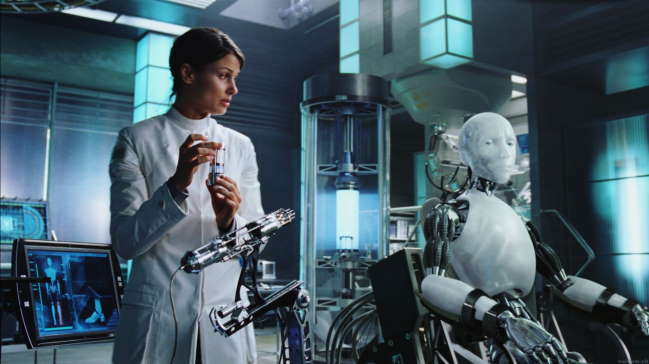
The Story: In the near future (2035), robots are a pervasive fact of life, and serve humans in a variety of capacities. US Robotics, maker of the fabled “NS” series of robots is just about ready to release their greatest innovation, the NS5 robots. NS5 robots are the most lifelike to date, and are destined to replace the ultra-reliable but outmoded NS4 model. The NS5s are guaranteed to stay new by receiving daily updates from US Robotics’s master AI system, “V.I.K.I.”
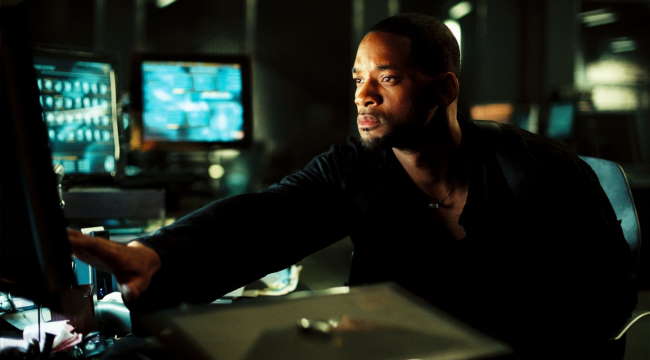
The week of the release, Dr. Alfred Lanning (James Cromwell), the founder of modern robotics dies in an apparent suicide. He leaves a clue behind for former patient and police officer Del Spooner (Will Smith). Del Spooner has reasons to hate and mistrust robots and immediately suspects foul play. US Robitics CEO Lawrence Robinson (Bruce Greenwood) is suspicious looking, and things just “feel” right.
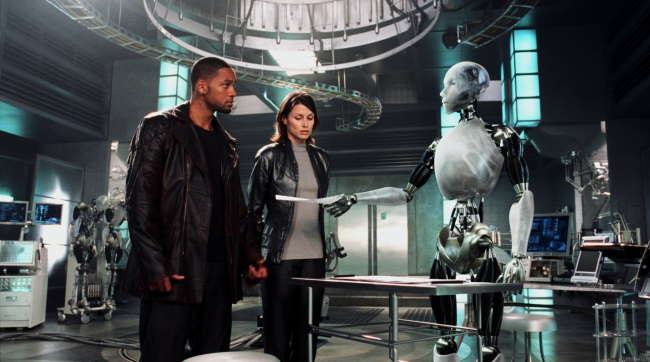
Assisted by robot psychologist, Dr. Susan Calvin (Bridget Moyanahan), Del finds an NS5 robot named Sonny, who appears to have freewill developed life-like features – so much that Del suspects Sonny of having killed Dr. Lanning. In following the breadcrumbs, Dels fears are realized – the robots do not seem to be adhering to the thee Laws of Robotics. Now they must race to uncover the real nature of the plot before the trap is sprung.
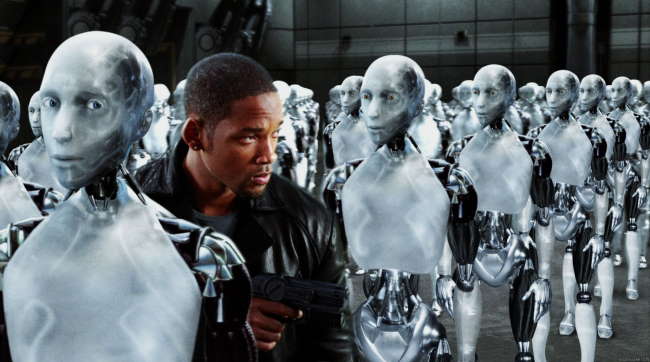
Will Smith Plays “Will Smith”…Again: You know the role – cocky, argumentative, underdog tough-guy cop – Be it MIB, ID4 or I, Robot, Will Smith plays the same old Will Smith. I, Robot was clearly green-lighted to bring in the teens to the seats over the summer – Will Smith is the guy to do this. Will Smith and massively cool FX = ROI. Unfortunately, it also engenders a far crappier story. Had we gotten an introspective no-name person in Smith’s role, we might have had a significantly higher degree of realism. But then again, realism would imply that things like the overblown US Robots Truck bashing scene wouldn’t have been included.

Sonny: If not for Sonny, I, Robot would be almost unwatchable. Sonny (voiced by Serenity star, Alex Tudyk) provides us an investigation into android humanity similar to Star Trek’s Data in his better moments. While some of it comes off as sappy, Sonny’s questioning of his right to exist, and more interestingly, his hopes that others consider him a being instead of an it provide the best moments of the movie. One can only wonder how much better I, Robot would have been if this aspect of the movie was highlighted vice the focus on Will Smith and the overblown FX scenes.
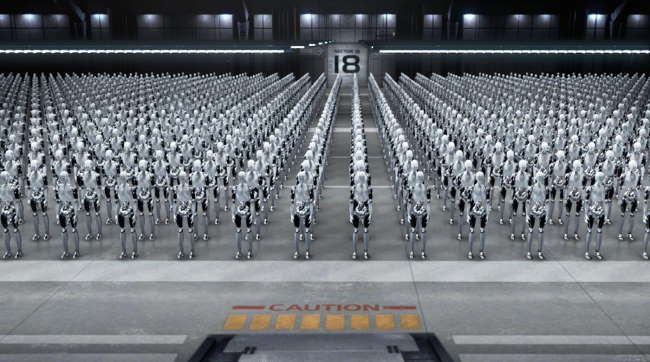
“There have always been ghosts in the machine – random segments of code that have grouped together to form unexpected protocols. Unanticipated, these free radicals engender questions of free will, creativity, and even the nature of what we might call the soul. Why is it that when some robots are left in the dark they will seek the light? Why is it that when robots are stored in an empty space they will group together rather than stand alone? How do we explain this behavior? Random segments of code? Or is it something more? When does a perceptual schematic become consciousness? When does a difference engine become the search for truth? When does a personality simulation become the bitter moat of the soul?”
Evolution of The Three Laws: I, Robot touches on some interesting questions concerning the three laws. If, taken to their logical extreme, do the laws imply, similar to Colossus: The Forbin Project, that machines should consider removing our freewill in order to protect us? Also, given a set of operating conditions that include the ability to learn from the environment, are we truly sure that machines would not eventually develop sentience and freewill? This is especially problematic when science has yet to deliver a definitive statement on how this comes about.

The FX: Yes, I, Robot delivers awesome android FX – continually so, in fact. The mandatory overblown chase scenes, massive explosions and lots of gun fighting are all there, but so are the robots. And the robots are simply amazing. Their facial expressions are lifelike, their exoskeleton muscles look believable, and their demeanor seems perfect. However, their cartoon-like ability to jump as high and far as they like is well past over-the-top. Worse, not all of the NS5s are equal, as near the end they transform into bumbling fools, where an army of them seems unable to stop two humans in possession of guns that never run out of ammo.

The Bottom Line: One wonders how great I, Robot could have become had the studios given Dark City director Proyas more of a free hand in its development. Instead, I, Robot is a summer blockbuster first, and an interesting cyberpunk movie second. Still, Sonny and the robot FX raises I, Robot to be more interesting and enjoyable than it has rights to be. The performances of the leads are pretty much all lackluster – make no mistake – Sonny is the star here, and dominates the screen during every appearance he makes. Normally I give overblown summer blockbusters with great FX five or six stars – Sonny, and the wonderful ending visual makes I, Robot deserve a bonus star.
~See movies similar to this one~
|

















































